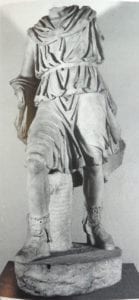The myth
AENEAS: MYTH AND HISTORY
Home – Myth
“What is the Mediterranean? Thousand things together. It is not a landscape but innumerable landscapes. It is not a Sea but a sequence of Seas. It is not a civilisation but a series of civilisations piled up upon each other”
(Fernand Braudel, The Mediterranean. 1985)
The Myth
The myth of the journey of Aeneas starts with the abandonment of the city of Troy, destroyed by the Achaeans and the boarding on the ships built on the shores of the city of Antandros, to continue across the Mediterranean, a sea already deeply interconnected and unified in ancient times, crossed by countless routes of peoples and individuals for the most diverse reasons, from wars to trade, from famine to conquests, up to the search for a new future. The myth of Aeneas is the echo of an ancient Mediterranean Sea characterized by lively mobility, by profound settlement changes, by the rapid evolution of social systems, and by the contact – often violent – between different cultures, in a context very distant from the stability that the Roman Empire will ensure to it in a second time.Aeneas is therefore the symbol of the encounter between different worlds, of renunciation and pain, but also of destiny and hope in the future.
THE MYTH
"Fate has established that he be saved, so that the lineage of Dardanus does not perish, sterile, annihilated ... But by now the mighty Aeneas will reign over the Trojans, and the children of his children and those who will then be born in the future”
(Iliade, XX, 302-308).
The powerful prophecy is pronounced by Poseidon, intervening to save Aeneas from certain death who challenged Achilles, the invincible, to a duel. The fate of Troy is sealed, but a very different fate is reserved for Aeneas, already from Homer in the Iliad. It is from here that Virgil starts when, in the first verses of the Aeneid, he links the destiny of the hero to the foundation of Lavinium – and then to Rome – and to the transport of the protector gods of Troy – the Penates – to Lazio
But, after the Iliad, the legend of Aeneas continues immediately afterwards: in the Homeric hymn to Aphrodite, in the poems of the “little Iliad” cycle, where however no mention is made of a migration to the West, and finally in the Greek and Latin literature.
Latin literature begins only from the third century BC. with Nevio and Ennio, who naturally already know and develop the Trojan legend of Rome; but the Greeks knew it well, in particular those of Magna Graecia and especially of Sicily, who were more attentive to the events of Italy and Rome. Among these, Stesicorus of Imera in the archaic age, who remembers that Aeneas is destined to found a new Troy; then, in addition to Sophocles, in the mid-fifth century. B.C. Damaste of Sigeo, in the Troad, and Ellanicus of Lesvos, for which Aeneas arrived in Lazio and is the founder of Rome, up to the historian of the early Hellenistic age Timaeus of Taormina and the tragedian Licofron, active in the first part of the third century. B.C. Unfortunately, only a few precious fragments of all these authors have survived.
The images depicted on archaeological finds help in the reconstruction of the development and diffusion of the myth of Aeneas.
Among the oldest findings we know in particular some vases of Attic production, dated roughly between 525 and 460 BC, on which appears the depiction of Aeneas’ flight from Troy, with his father Anchises standing on the shoulders of his son; in fact he, according to the myth, after having promised to keep a love encounter with the goddess Venus, from which Aeneas was born, he had then boasted about it, drunk, during a party and for this he was punished by Zeus with paralysis. This iconography prevails in the Etruscan context and later in the Roman imperial age.
Another group of vases, however, represents Anchises who can walk, but is carried by the hand by Aeneas since, according to a different version, he was punished with blindness; an image that is also present on one of the metopes of the Parthenon in Athens.
This archaeological documentation demonstrates that in the classical period Athens takes on the myth of the surviving Trojans and does so in a positive way: they are the traditional enemies, but respect for their virtues is due to them. This is the message that Athens officially consecrates, welcoming it even in the main monument of the city, the Parthenon, and which it spreads to the West through the export of its vases with the depiction of Aeneas and his invalid father.
In fact, in reality, rather than a real “escape” of Aeneas secretly from the city, it was the Greeks (Achaeans) who after the victory over Troy had granted Aeneas and his own lives, in compliance with reciprocity clauses and trust, bonds of hospitality, and by virtue of previously acquired rights, thanks also to the balanced attitude of Aeneas and Antenore (who in fact also flees from Troy and arrives in Italy where he will found Padua), who had been supporters of the return of Elena.
The Greek legend of Aeneas spreads in the West, both in Etruscan and in Roman environments, but it is not easy to explain its stages and methods.
The two strands, Etruscan and Roman, will find a unification in the work of Virgil: in his grandiose poem the story of the Trojan hero takes place entirely and Virgil transforms the story of the Trojan refugee into the epic of the formation of Italy as a first ideological unit still than ethnic: Italy united is a composite history interwoven with wars. What is decisive in Virgil, and makes Aeneas’ journey appear not as a migration of exiles, but as a return, a real nostos, is the alleged origin from Italy of Dardanus, progenitor of the Trojans, so that all their troubles become the search for an antiqua mater (in the words of the prediction of the oracle of Apollo in Delos), a land of origin in which to return and forever relocate the sacred Penates of Dardanus and Troy.
Aeneas brings with him the sacred of Troy, the objects that symbolize the cults, the traditions, the life of the city itself: his journey does not aim simply to found a new city, but rather to find a place to transfer one’s homeland .
In the Aeneid the Trojan myth is associated with the ideology of the principality: the pius Aeneas is the progenitor of Caesar Augustus and the glorification of the princeps is placed by Virgil at the very opening of his poem, where it is Jupiter himself who reassures Venus of the grandiose destiny of the lineage of son, who will have dominion over the Achaeans – the Greeks – at the time victors over Troy: the legend of Aeneas now legitimizes the conquests of Rome. In the story of Dionysius of Halicarnassus, who wrote his work immediately after Virgil’s death (Roman Antiquities, Book I, chapters 45-64) and who may have known the Aeneid, the story of Aeneas is slightly different. After describing the escape from Troy, the author declares that he follows the tale of Hellanicus of Lesbos, which of all sources he considers the most reliable. For Dionysius, Aeneas with his family stops off in Aineia, in the Chalkidiki peninsula, and in Delos; then he stops in Zakynthos, completes the circumnavigation of the island of Lefkada and enters the Gulf of Ambracia: the Greek historian, not tied – unlike Virgil – to the needs of Augustan propaganda, does not give importance to the stop at Actium. With the arrival in the Laurentian territory and the founding of Lavinio, the Trojan exiles, of Greek ancestry, merge with the Aborigines of Latino, who for Dionysius are also of Greek descent, originally from Arcadia; in this way the historian wants to demonstrate the Greek nature of the origins of Rome.
Even the work of the historian Tito Livio (59 BC-17 AD), Ab Urbe Condita, opens with the mythical story of the arrival of Aeneas, who fled from Troy at the time of the Greek conquest, on the coasts of Lazio, where he will found the city by Lavinio. Livy, without any mention of Carthage and the meeting with Dido, so important in the Aeneid, knows only three stages of Aeneas’ journey: Macedonia, Sicily and finally Lazio; other differences with the Virgilian tale are then in the facts after the landing and in the story of the war against the Rutuli.
It is with the Augustan princedom that the figure of Aeneas becomes one of the most pervasive in the Roman world, not only as a semi-divine character, son of Venus, who is at the origins of Rome, but also as the ideal model of the Roman citizen, devoted to the gods and respectful of the family. And it is for this reason that the iconography of the myth of Aeneas will become a recurring theme both in official art, with its statues placed in the Forum of Augustus in Rome and in the forums of the provincial cities (such as Merida, Carthage, Cologne, Ilio and Aphrodisias in Asia Minor), and in the private sphere (in objects of common use, in the frescoes of houses, in funerary monuments, etc.).
Parts of the sculptural group depicting Aeneas, Ascanius and Anchises from the forum of Merida (Spain), ancient Augusta Emerita, capital of Lusitania
(from Dardenay 2010)

More information






























Previous
Next
















